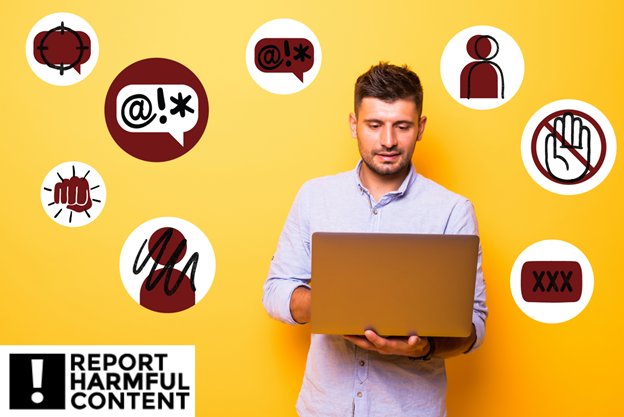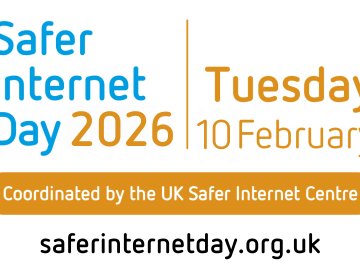When someone comes to us, they are usually distressed. Coming across harmful content or being the target of it, can trigger a stress response, clouding our minds and make it difficult to explain, and prove what has happened.
For that reason, we’ve decided to provide our top 5 tips for reporting harmful content.
It all comes down to:
- remaining calm
- collecting evidence
- using the correct reporting routes
- looking for support
- getting involved
We will be going through these 5 tips and hopefully the next time you come across harmful content you’ll feel empowered to report it.
1. Keep Calm
Most of the scams that we come across at Report Harmful Content rely on making the victim/target feel desperate. Which usually leads to instinctive behaviour, like turning off the laptop and deleting everything.
Our first tip is probably the most important one: “keep calm”. Keeping calm allows you to view the issue from a different perspective. It also stops the domino effect that these people frequently rely on.
We recommend asking yourself:
- Is someone in immediate danger?
- Has a threat to someone’s life been made?
- Has someone’s safety been compromised?
- Is someone being forced to take part in sexual behaviour online?
If you said “yes” to any of the previous questions, please contact your local police. If not, there are a few things you can do to stop online harmful content, such as gathering information.
2. Gather Information
Screenshots are incredibly helpful. Some content is removed quickly after being published. For this reason, whenever you see it, record it. When reporting you can use all the information you’ve collected.
Saving messages can be very important to give context to harassment and other harmful content. Some platforms can’t access private messages even when you report them, so saving those screenshots can be extremely useful. If you are unsure about how to take a screenshot take a look at this wikihow article.
We recommend taking note of the time, date, location (URL) and if you know the platform administrator, great, save that information too. A bit like a journalist, if you can write down: “what, when, why, who, where and how”, brilliant!
Most of the time this sort of context allows us, and other services, to advise you properly. There are different angles to a story, and we might be able to help you if we know the context and have proof of the abuse.
After you gather the information the key is to understand the correct reporting route.
3. Use The Correct Reporting Route
When you find harmful content online you can report it directly on the Report Harmful Content platform. This should be the first step to get content removed. Most social media platforms have their own reporting tool and it’s fairly easy to use. If in doubt, you can look at Report Harmful Content and see how to report to a specific social media channel.
On many platforms, initially at least, your report may not be viewed by a human but a computer, this is why it is very important to select the correct report.
Example: reporting impersonation will trigger a different algorithm than abuse, so we always advise people to have a look at the report form you use and check it’s adequate for the issue you identified. Things To Remember When Reporting To Social Media.
Platforms that don’t have a reporting tool as obvious as Facebook, Snapchat and TikTok, need a bit of research to contact the page administrators. Usually you can find an email on their contact page, on the top or bottom of the page. Plus, sometimes at the bottom of the page you will see their terms and conditions in which it’s frequent to find their ‘reporting abuse’ email.
At Report Harmful Content we work with a wide range of platforms. We assist by acting as a mediator between clients and industry, escalating issues directly with industry and advocating for clients where necessary. Before you submit a report to us it is essential that you have reported the material to the social media service directly using their online tools (at least 48 hours before).
Sometimes the reports we receive are out of our project’s remit but we still do our best to give the appropriate advice. If you want, you can find out more about graphic content on independent sites, including why we're unable to help and what further steps you can take.
More and more often we’ve seen cultural and religious background adding a sensitive layer to harm when dealing with online content. Some content might be harmless for a typical westerner, but when seen through a different cultural lens it can put (especially) women in danger. Muslim girls for example have even more pressure after falling victim to online harm. If you are in a situation similar to this, we would advise you to contact the Muslim Women's Network UK (MWNUK) for extra support.
In some cases, removing online content won’t stop the perpetrator, for that reason we advise you to contact the police and some organisations to get legal support. You can find a list of organisations to support all manner of on and offline harm on reportharmfulcontent.com.
Dealing with harmful content is often disturbing. This is why we believe that after reporting, it is fundamental to look inwards and take care of ourselves.
4. Take Care Of Yourself
We understand that even after the content is removed, it can have a lasting impact on you. For that reason, it is important, after you have done what you can to report, to take care of yourself. Ceasing communication with the perpetrator, blocking the person and walking away can be really important to move on with your life.
Unfortunately, not everyone gets closure and we recommend, where possible, speaking to someone you trust about what has happened. It could be someone you know or perhaps you’d prefer to seek help from a support organisation. Whoever you decide to talk to, the important thing is to seek support. No person is an island and we are stronger when connected.
Depending on the issue you are facing there are many good people dedicating their time to support those going through similar issues. Frequently the first step is to contact your GP. You can find other support services on reportharmfulcontent.com.
5. Get Involved
If you think the only way to make a difference is to speak out for change, helping everyone benefit from a safer internet, welcome to the pack!
We started this year with a campaign to pay homage to young women activists changing the world. And we are about to start a new one to talk about young men stepping up and challenging male stereotypes that are in dire need of an update. So many of us see how we are being constrained by social / cultural expectations, and we believe we can do better.
We want to empower everyone to report, to engage proactively and positively online. Above all, we want to stop the issues before they transform people’s lives. For that we need to connect, to talk when we see online harm happen. Finally, we need to keep making our voices heard by lawmakers so they create laws that protect every member of society.
There are law reforms happening, let’s engage and be part of that process.
Another way of taking action is to speak up (if you’re safe) when you see injustice and harm online. There are many routes to report harmful content. We want to empower everyone to raise their voice and to make sure they are using the tools around them for their best interest.
On top of this, we are approaching Safer Internet Day, which happens on the 9th February. Every February since 2004.
Organised by the Insafe/INHOPE network of European Safer Internet Centres (SICs) with the support of the European Commission – has been a global, community-led observance which provides a space for all stakeholders to reflect on how together we can promote a responsible, respectful, critical and creative use of digital technologies. The ultimate goal is fostering a better internet for all. Visit www.saferinternetday.org to get an idea of how our SID committees and supporters are celebrating SID 2021, and to find a variety of resources and inspiration for your own plans.
We hope this information helps, and now you feel like you have a toolkit to tackle harm online
Follow us on Social Media to get inspiring and informative content!






